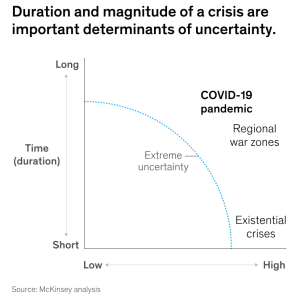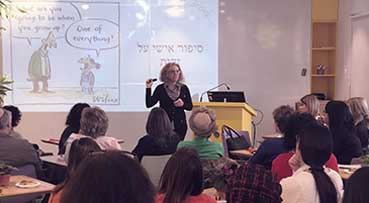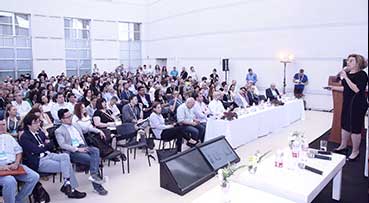The COVID-19 pandemic has redefined global expectations for a more balanced work-life equation. People are increasingly unwilling to fit their lives around work; they demand that work fits into their life. While the pandemic may be over, allowing some to think we can revert to old work norms, Work@War teaches us that we cannot ignore individual needs in the name of organizational needs.
McKinsey’s analysis at the onset of the COVID-19 pandemic illustrated how the magnitude and duration of a crisis significantly contribute to the uncertainty it generates. In Israel, the ongoing war, encompassing both the endured part and what lies ahead, intensifies this uncertainty, challenging organizations to balance business continuity with human resilience.

On one hand, the social contract is unequivocal: organizations must not penalize those who couldn’t work in recent months due to their participation in the conflict. On the other hand, the economic imperative is also clear – these organizations must continue operating. However, it’s important to recognize that there are multiple ways to work and adapt in these times.
Nowhere is this more evident than in conflict zones. Talking about social responsibility is easy in times of peace. It becomes more challenging when caught in the crossfire of business continuity and personal wellbeing, a dilemma we’re experiencing firsthand in Israel as we navigate Work@War. But as we’re learning, Work@War magnifies issues prevalent in the changing world of work globally. Now, we understand that while our intentions may be to act socially responsibly, this alone does not fully protect against unintended consequences.
Let me illustrate through the experiences of a specific subset of the workforce in Israel during the past months of war – particularly, the spouses of reservists, mostly women. Imagine your partner is called away suddenly and remains absent for months. Without the additional strain of war, you’re effectively a single parent, balancing this with your job responsibilities. Add to the equation the war, weeks without schools, constant sirens, and the overarching stress, and you have a scenario where the ability to focus and work effectively is significantly diminished.
During the initial weeks of the conflict, flexibility was the norm, with widespread empathy and support for those unable to work normally. However, as weeks turned into a month, organizations began to ‘normalize’ the situation, setting clearer boundaries around flexibility due to the need for business continuity. Acknowledging that the wartime scenario wasn’t a fleeting event, it became clear that indefinite full consideration was not feasible. Only a few organizations managed to offer full flexibility to those who couldn’t maintain their usual work pace without repercussions.
In today’s rapidly evolving workplace, organizations must master the art of managing employees with utmost flexibility to stay afloat. Ethical behavior has transitioned from being optional to a demand from employees. They’ve realized that when work-life balance is at stake, life invariably triumphs. To retain their workforce, businesses must avoid forcing employees to choose between the two. This approach includes exploring every possible avenue before resorting to layoffs, especially during such tumultuous times.
However, that alone isn’t sufficient. As conflicts prolong, it becomes increasingly apparent that businesses may not be able to guarantee employment for everyone involved. While maintaining employment may be the “right thing to do,” it’s not always sustainable due to normal business factors such as product closures, downsizing, halted recruitment, and other economic constraints. This necessitates a conversation about a new social contract and innovative solutions, ones that provide a comprehensive safety net – not just financially, but in every aspect – for all impacted by the war.
Beyond Full Time
The war has spotlighted the unique challenge of individuals capable of working, albeit not at their full capacity. This includes those left to manage families alone while their partners serve in the reserves, those displaced with families and living out of routine, parents of children deeply affected by the war, and reservists who, upon returning to work, face imminent redeployment or require a period of adjustment. These are people eager to work, yet constrained from performing normally.
The state has a significant role in addressing these needs. Consider Germany’s Kurzarbeit program, a model designed to stabilize the labor market during challenging times. It enables companies to reduce employee working hours instead of laying them off, with the government compensating for a significant part of the income loss. But it’s more than just financial aid; it provides employees who seek it with access to training resources, fostering adaptability and resilience in the workforce.
Transition Assistance for a Workforce in Flux
In routine times, when advanced industries face layoffs, many organizations offer support packages to assist the laid-off employees in finding new opportunities. There’s no reason not to replicate this model at the national level, expanding it to ensure that every reservist dismissed within a year of their service end is provided with organized support to secure new employment. This support should also extend to the self-employed, aiding them in reviving their businesses, as well as those who were job-hunting or in the midst of recruitment processes and lost opportunities, and even students returning from reserves and seeking their next venture.
Harnessing the collective effort of employers’ and workers’ organizations could significantly benefit this process. Take Sweden’s job security councils as an example. These non-profit entities, managed and funded in collaboration with employers and trade unions, present a unique model of cooperation in workforce management. They offer a comprehensive framework for navigating job and career transitions, particularly in scenarios of financially-driven layoffs. These councils, not governmental bodies, focus on maintaining employment continuity, balancing organizational needs with proactive involvement in employment change processes. They’ve established a support network featuring transition agreements, career transition assistance including counseling and placement, and training for future skills and roles, all under employment agreements. The largest council, TRR, reports that 9 out of 10 job seekers they assist find employment. Notably, their funding comes from wage increases, approximately 0.3% of employers’ wage costs.
So, let’s return to those employees struggling to balance their unique Work@War circumstances with regular hybrid work policies. Instead of sidelining them with trivial projects or suggesting a reduction in work scope or employment, we encourage organizations to seize this as an opportunity to evolve their management approach – learning to set clear, measurable goals and then managing based on the results, offering complete flexibility in how these goals are achieved.
We’re also challenging our organizations to think differently about employees who were out on reserve duty and are now back but may be called up again in a few months, as the war is not over. We’re asking organizations to explore various options, teaching them to think more flexibly about the needs of careers, personal considerations, and the organization. They could offer the returning employee to resume their usual role for the interim, or they could engage them in projects, mentoring, or other meaningful activities. This approach ensures their contribution remains valuable and developmental, without detriment to them or the organization. And just as importantly, it hones the organization’s ability to adapt to a changing world where flexibility in breaking down jobs into tasks becomes increasingly crucial for both organizational and personal growth.
Ultimately, the war will end. Yet, the lessons learned extend far beyond the battlefield, influencing how we view and approach work in times of crisis and beyond. Our objective is to preserve a society that adheres to its values while maintaining a robust economy. This experience teaches us the importance of agility, empathy, and innovation in the face of adversity. As we move forward, we’re learning to navigate the Work-Life conversation beyond a zero-sum game. It’s not just about balancing the scales between professional demands and personal needs; it’s about creating a new paradigm where both can coexist and mutually reinforce each other. In doing so, we’re not only responding to the immediate challenges but also setting the stage for a more resilient and adaptive workforce in the future.

![large-AX1A2125-2[1] large-AX1A2125-2[1]](https://niritcohen.com/wp-content/uploads/elementor/thumbs/large-AX1A2125-21-pnzedcs72atx5aeurqytqdiihxixlq02re9mlz805s.jpg)






